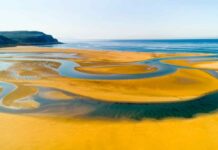The Land of Fire and Ice is famous for snow-capped mountains, active volcanoes, natural hot springs, and fascinating rock formations. Naturally Iceland is teeming with a rich history of folklore inspired by the dramatic Icelandic landscapes and mystical environment. Icelandic folklore also reflects the evolution of religion in this nation, drawing influences from Nordic mythology, Christianity, and Celtic fairy tales. Isolation and dark nights created the perfect breeding ground to breathe life into stories about elves and trolls in Iceland.

Trolls in Iceland
These legends are built into the tapestry of Icelandic tradition and superstitions. In fact, to this day locals respect the land of elves and Hidden People by moving construction sites. Let’s learn more about these fantastical creatures and find out why Icelandic children are scared of Santa’s little helpers.
All About Iceland Trolls
Trolls have a bad reputation. I’m sure you want to know all about Iceland Trolls and how they’ve developed such a bad reputation over time. They’re known as big and slow creatures that only come down from the sweeping Highland mountains in search of food. Be careful because they can harm you if crossed and they also like the taste of human flesh. Trolls use spells and potions to lure people to their caves. Parents threaten their children with the idea of these greedy and magical beings eating them if they misbehave. But not all encounters with trolls are negative because they will grant you a reward if you help them.
Trolls need total darkness to survive because if a ray of sunlight touches their rough skin they can turn to stone. In the summer season when the midnight sun burns brightest they remain hidden until it’s safe to hunt again. But you can see many unlucky trolls scattered throughout the country as twisted rock formations. The most known rock troll is called Reynisdrangar found in the South Coast of Iceland in the village Vik. The structure shoots out of the water in an imposing fashion and is under the beautiful mountain cliffs of Reynisfjall.
The origin story is fascinating. As legend has it, two trolls tried to drag a large ship to shore but did not time it well. Before they could get to shore the sun rose and the two trolls and ship turned to stone. To this day, the famous basalt rock formation serves as a warning to other trolls about the dangerous sun. You can find other trolls in West Iceland to see Troll Woman’s Peak and in North Iceland to visit Troll’s pass. The sheer drama of these structures is well worth the visit for curious tourists.

Icelandic Christmas Trolls
Icelandic Christmas Trolls are the stuff of nightmares and daydreams. The contrast is very similar to the sometimes harsh but beautiful landscape in Iceland. The most feared troll is the mother troll Gryla who comes out in December and enjoys eating children.
Gryla has a frightening appearance with her hooved feet, three heads, 15 tails, and horns. However, there has been a long-standing debate over all of her fearsome features. Either way, in December she brings her big sack to villages and gathers children who are misbehaving and lazy. Then she makes a soup or stew out of them.
She also has a pet cat called the Yule Cat that enjoys eating children who do not have new clothes on Christmas Day. It was a great tactic used to get kids to do their chores. Then, as a reward, they would receive new clothing as a gift on Christmas Eve. It’s no wonder children behave well around Christmas time. Now let’s learn more about Gryla’s family and her Yule Lad children.
Who are the Yule Lads?
Gryla and the male troll Leppalúði are the parents of all thirteen Yule Lads, who eventually became Iceland’s Santa Clauses. The Yule Lads live in dark caves with their parents and Yule Cat. They typically stay hidden until December. So when you see them it notifies the people in Icelandic villages that Christmas season has started.
Initially, the Yule Lads were troublemakers with names that reflected their brand of mischief. For example, Spoon-Licker for licking and stealing spoons and Pot-Scraper for stealing leftovers from pots. Other names you can infer the meaning from are Door-Slammer, Candle-Stealer, Sausage-Swiper, Window-Peeper and more. For example, the Door-Slammer loves to slam the door in the evenings to disturb the villagers.
Then eventually the thirteen Yule Lads turned into the traditional Santa Claus archetype we see today. During the thirteen nights before Christmas Eve, one of the new “Santa Clauses” comes to town. If the children were good they received a treat, but if they were bad they would have rotten potatoes waiting for them on the windowsill. However, their mother Gryla is still true to her original role and will occasionally eat disobedient children. Along with the family pet, the Yule Cat that loves eating children. Very interesting tales to regale young children with to keep them well behaved during the holiday season. You can see these colorful beasts in person when you visit the Troll Park in Fossatun.

Elves and Trolls in Iceland
Elves and trolls are treated very differently in terms of reverence in Iceland. Unlike trolls, elves have a kinder description and are far more attractive than trolls. Stories of elves, commonly called the Hidden People, are described as beautiful and very powerful. Elves in Iceland are said to live inside magically enchanted rocks and cliffs designed to be hidden from prying eyes. People believe elves live lives parallel to that of humans. They have daily activities such as maintaining livestock and fishing on boats in the North Atlantic Ocean. They even go to church on Sundays.
The elves living in Iceland only show themselves on special occasions such as New Year’s Eve and Midsummer’s Night. Naturally, the Hidden People are very protective of maintaining the sanctity of their homes. And like the trolls, if they are crossed they will go to extreme measures to protect their space when disturbed. Icelanders to this day have a healthy respect for and belief in elves.
There are many examples of cancelled plans to prevent any disturbance on enchanted land. One example was in 2015. There were plans to pave a new Iceland road through an enchanted part of a lava field. During construction, many disasters occurred such as heavy machinery frequently breaking and many freak accidents among workers. All of these disasters caused the company to move the road construction to an area that was not elfin occupied. If you insist on building on elfin land you will need a special person to ask the elves’ permission. This step is important to do in advance for disaster prevention.
The Elf School
If you want to learn more about elves, trolls, and magical creatures you should attend the Elf School in Reykjavik. The course is 3-4 hours long and you’ll receive a great textbook to take home and read. It’s a wonderful way to spend your afternoon and learn all about how these mystical beings evolved over time. You will also gain an understanding of the Icelanders’ ongoing belief in the existence of trolls and elves.



































